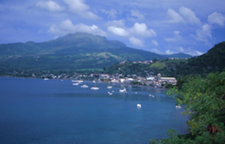 |
Newspaper
Article
I
will begin by sharing with you an article I have saved for many
years. Perhaps that way you will better understand how precious
our jewel of an island is to our people and to the visitors
who have grown to love it.

Montserrat: The Caribbean As It Used
to Be
June 26, 1988
For centuries Montserrat was a small, half-forgotten
island in the Caribbean, overshadowed by the more coveted islands
of Antigua to the northeast and Guadeloupe to the south. It
is only 13 km long by 8 km wide, and it has only one port of
entry, Plymouth, the only town of any size. From the azure seas
that surround the island, the lush, fertile terrain quickly
rises to a series of peaks of volcanic origin. The highest is
Chance's Peak at 915 meters. Because of Montserrat's small size,
lack of alternate ports, and hilly terrain, the island never
played a leading role in the West Indian sugar industry. But
what was once a drawback has now become a tremendous asset.
Montserrat remains a peaceful, unspoiled, friendly place. It
is poised to become a coveted tourist destination for adventurous
travelers.
 Montserrat
has one airport, and most visitors arrive here by small plane
from Antigua. As you cross the mountains on a narrow paved road
to reach Portsmouth, you realize why it has been nicknamed the
Emerald Isle of the Caribbean. The scrub vegetation and turquoise
waters along the coast give way inland to a deep-green rainforest
where huge tree ferns and philodendron leaves lord over tiny
pink impatiens and wild orchids. Many trails lead through these
forests. The most popular trails lead to the island's natural
wonders. At the Great Alps Falls the stream drops 21 meters
into a lovely natural grotto. The Soufriere Hills are blanketed
with rainforest and volcanic peaks. Galway's Soufriere is a
surreal setting of bubbling muddy water, steamy fumaroles, hot
sulfurous springs, and other volcanic curiosities. Galway's
Plantation is the newly excavated ruins of a 17th-century plantation.
And the Bamboo Forest features bamboo canes up to 24 meter high
that creak in the gentle winds that rise from the sea. The government
is committed to maintaining these trails and developing new
ones. With few cars, more than one hundred miles of paved roads,
extremely friendly people, beautiful trails, and government
support, Montserrat is a hiker's paradise. For a truly memorable
outing ask for Melvin Clifton in Plymouth. Montserrat
has one airport, and most visitors arrive here by small plane
from Antigua. As you cross the mountains on a narrow paved road
to reach Portsmouth, you realize why it has been nicknamed the
Emerald Isle of the Caribbean. The scrub vegetation and turquoise
waters along the coast give way inland to a deep-green rainforest
where huge tree ferns and philodendron leaves lord over tiny
pink impatiens and wild orchids. Many trails lead through these
forests. The most popular trails lead to the island's natural
wonders. At the Great Alps Falls the stream drops 21 meters
into a lovely natural grotto. The Soufriere Hills are blanketed
with rainforest and volcanic peaks. Galway's Soufriere is a
surreal setting of bubbling muddy water, steamy fumaroles, hot
sulfurous springs, and other volcanic curiosities. Galway's
Plantation is the newly excavated ruins of a 17th-century plantation.
And the Bamboo Forest features bamboo canes up to 24 meter high
that creak in the gentle winds that rise from the sea. The government
is committed to maintaining these trails and developing new
ones. With few cars, more than one hundred miles of paved roads,
extremely friendly people, beautiful trails, and government
support, Montserrat is a hiker's paradise. For a truly memorable
outing ask for Melvin Clifton in Plymouth.
 Montserrat
is nicknamed the Emerald Isle for more reasons than its physical
similarities with the island of Ireland. Among the original
European settlers were Irish Catholics who migrated here from
the British island of St. Kitts. Many place names, such as Galway,
hark back to those times. Some people swear that Montserratians
speak with a bit of the Irish brogue. St. Patrick's Day is a
national holiday, and visitors' passports are stamped with a
shamrock! Montserrat
is nicknamed the Emerald Isle for more reasons than its physical
similarities with the island of Ireland. Among the original
European settlers were Irish Catholics who migrated here from
the British island of St. Kitts. Many place names, such as Galway,
hark back to those times. Some people swear that Montserratians
speak with a bit of the Irish brogue. St. Patrick's Day is a
national holiday, and visitors' passports are stamped with a
shamrock!
 When
you reach the capital of Plymouth, home to a quarter of the
island's 13,000 residents and reputed to be the cleanest town
in the Caribbean, you get the feeling you have gone back in
time to the reign of the British Empire. Large shade trees and
Georgian-style homes, reputedly built from the ballast brick
of early sailing vessels (gold and other treasures became the
ballast for the return voyage to Europe), line the town's main
street. Set on a hill, Government House is vintage Victorian
architecture surrounded by tropical gardens. Two shops sell
beautifully made towels, shawls, and other items woven out of
locally grown sea-island cotton. The beach here (like most beaches
on Montserrat) has black sand, a quaint reminder of the island's
volcanic past. Interesting sites found near Plymouth include
Fox's Bay Bird Sanctuary, swampy home for herons and other coastal
birds; the Montserrat Museum, a collection of artifacts and
exhibits set in the former windmill of a sugar plantation; and
Rendezvous Bay, Montserrat's only pale-sand beach. When
you reach the capital of Plymouth, home to a quarter of the
island's 13,000 residents and reputed to be the cleanest town
in the Caribbean, you get the feeling you have gone back in
time to the reign of the British Empire. Large shade trees and
Georgian-style homes, reputedly built from the ballast brick
of early sailing vessels (gold and other treasures became the
ballast for the return voyage to Europe), line the town's main
street. Set on a hill, Government House is vintage Victorian
architecture surrounded by tropical gardens. Two shops sell
beautifully made towels, shawls, and other items woven out of
locally grown sea-island cotton. The beach here (like most beaches
on Montserrat) has black sand, a quaint reminder of the island's
volcanic past. Interesting sites found near Plymouth include
Fox's Bay Bird Sanctuary, swampy home for herons and other coastal
birds; the Montserrat Museum, a collection of artifacts and
exhibits set in the former windmill of a sugar plantation; and
Rendezvous Bay, Montserrat's only pale-sand beach.
Hotels on Montserrat are as charming as the
island. Best known is (please turn to page 7)

I'm sorry to report that over the years I
have lost page 7.
Beginning in the 1970s, famous rock stars
began visiting our island! Did you know that the Englishman
George Martin, producer of most of the Beatles' albums, installed
a complete state-of-the-art recording facility on a hilltop
above Plymouth, and singers the likes of Jimmy Buffett were
often glimpsed in town! We have a medical school, and its students
rent our rooms, eat our food, and explore our island, greatly
adding to the modest economy.
When Hurricane Hugo churned over us in 1989,
we suffered great damage. Crops were lost, trees were downed,
and many houses lost their roofs. But we recovered, and five
years later the ravages of the hurricane were scarcely noticed
by newcomers to the island.
Sincerely,
Melvin Clifton Proprietor
Footnote:
Melvin Clifton is a fictitious character. Any relationship to
organizations or persons past or present is strictly coincidental.
|
 |